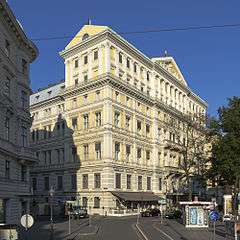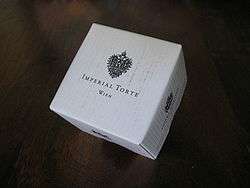Hotel Imperial
| Hotel Imperial | |
|---|---|
 Hotel Imperial in Vienna, Austria | |
| General information | |
| Location |
Ringstraße, Vienna, Austria |
| Opening | 1873 |
| Design and construction | |
| Architect | Arnold Zenetti |
| Developer | Heinrich Adam |
| Website | |
| http://austria.starwoodhotels.com/imperial.html?&L=en | |
The Hotel Imperial, also known as The Imperial, is a five-star luxury hotel in Vienna, Austria. It is located at Kärntner Ring on the Ringstraße.[1]
Description
The Hotel Imperial façade is Italian Neo-Renaissance. The top of the building contains a stone balustrade that frames allegorical animals from the Württemberg coat of arms.[1] The main entrance portal contains four statues that are also symbolic.[1] The original portal was wide enough for a two-horse-drawn carriage.[1]
The hotel's interior furnishings highlight the nineteenth century Viennese elegance with ornate marble, hand-carved statues, and massive crystal chandeliers.[1] In the lobby, the Royal Staircase leads up to suites and rooms that are also illuminated by magnificent chandeliers hanging from the high stucco ceilings. The hotel's private balconies offer views of the Altstadt skyline.[1]
History
The building was designed by architect Arnold Zenetti and built under the direction of Heinrich Adam in 1863.[1] Initially, it was planned as the city palace (Stadtpalais) and residence of Duke Philipp of Württemberg (1838-1917) and his spouse Duchess Marie Therese (1845-1927), née Archduchess of Austria; its original name was Palais Württemberg.[1] The Duke and the Duchess, however, did not enjoy their new home for long. After moving there in 1866, they sold it five years later. For the Universal Exhibition it was converted into a hotel in 1873.[1] In 1928, two stories were added. But the original architecture is still very much in evidence and is an integral part of the luxurious atmosphere.
Over the years, the Hotel Imperial has had numerous famous guests, including Queen Elizabeth II and Charlie Chaplin. Dignitaries and royalty from around the world stayed at the Imperial. It has had some infamous guests as well. Adolf Hitler, who worked at the hotel as a day laborer during his youthful period as a virtual tramp in Vienna, returned as an honored guest following the 1938 Anschluss. Also, Benito Mussolini stayed at the hotel during World War II but was shepherded through the back door on September 13, 1943, following his spectacular rescue by German paratroopers in Unternehmen Eiche (Operation Oak).

The Imperial was acquired by Compagnia Italiana Grandi Alberghi (CIGA) after Prince Karim Aga Khan acquired the company in 1985 and began expanding its presence—which was purely Italian up to that time—into Spain and Austria. In 1994, the Starwood Hotels and Resorts took over CIGA and transformed it into its brand, The Luxury Collection, an assemblage of historic and venerable hotels in Europe that includes the Imperial.
The Imperial Hotel was partly owned before the war by a Jew, Samuel Schallinger, who was forced to sell in 1938 and died in 1942 at the Theresienstadt camp near Prague.[2]
Simon Wiesenthal, a Jewish Austrian survivor of the Nazi death camps who dedicated his life to documenting the crimes of the Holocaust, celebrated his 90th birthday at the Imperial Hotel in 1998 with a kosher dinner party. “Look, even the chandeliers are shaking,” said Wiesenthal at the dinner. “Hitler is gone. The Nazis are no more. But we are still here, singing and dancing.”[3]
Today, The Imperial is, perhaps, Vienna's most exclusive five-star hotel. Guests of state typically stay at the hotel, such as the Emperor and Empress of Japan on their visit in 2002.
A speciality of the house is the Imperial Tart or Imperial Torte as it is called, which is a chocolate truffle, supposedly based on a secret recipe that is said to have been created by an apprentice cook who fashioned it when Emperor Franz Joseph opened the Hotel in 1873. The confection comes in either a plain pinewood box or a cardboard box (for shipments), each containing a single torte or group of small tortes. Tortes vary in size, from ones that are the size of an individually wrapped candy to others that are the size of a small cake (approximately six inches or fifteen centimeters). A complementary torte box is provided to each guest room and additional boxes can be ordered from the hotel for shipment. Nowadays, torte boxes are sold alongside other Imperial products, such as teas leaves and coffee beans (labelled "Imperial Teas and Coffee") and other varieties of chocolate confections. The Imperial ships its products worldwide, as the chocolates maintain freshness for two months.
Marjana Gaponenko's novel Who is Martha? (New Vessel Press, 2014) is set in the Hotel Imperial. Its protagonist, a 96-year-old ornithologist, checks into the Elisabeth Suite, where he lives his last days in luxury, befriending hotel staff and guests.
References
- 1 2 3 4 5 6 7 8 9 "Hotel History". Hotel Imperial. Retrieved 9 November 2013.
- ↑ Erlanger, Steven (7 March 2002). "Vienna Skewered as a Nazi-Era Pillager of Its Jews". The New York Times. NYTimes.com. Retrieved 2013-08-29.
- ↑ "Simon Wiesenthal's Gravestone Unveiling" (Press release). Simon Wiesenthal Center. 23 February 2006. Retrieved 2013-08-29.
- Andreas Augustin. The Most Famous Hotels in the World: Hotel Imperial Vienna. 1999. ISBN 978-3-900692-03-2
External links
| Wikimedia Commons has media related to Hotel Imperial, Vienna. |
- Hotel Imperial
- Imperial Torte
- Vienna's tourist trail of plunder, Guardian (World News), 21 May 2002.
Coordinates: 48°12′04″N 16°22′23″E / 48.2011°N 16.3731°E